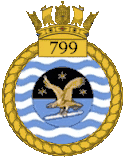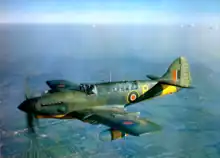| 799 Naval Air Squadron | |
|---|---|
 799 NAS badge | |
| Active | 10 September 1943 - 20 June 1944 30 July 1945 - 12 August 1952[1] |
| Country | |
| Branch | |
| Type | Fleet Air Arm Second Line Squadron |
| Role |
|
| Size | Squadron |
| Part of | Fleet Air Arm |
| Motto(s) | To d'ey nicata (South African dialect for ‘May the right prevail’)[2] |
| Insignia | |
| Squadron Badge | Barry wary of twelve white and blue, a rounde per fess black and blue charged with an eagle volant gold in the claws a torpedo white in chief three estoiles gold (1943)[2] |
| Identification Markings | uncoded (1943-1944) L8A+ & L9A+ (1945)[3] 751-787 (1946) 100-154 & 200-206 (from May 1948) 201-235 (from January 1952)[2] |
| Tail Codes | LP (1946) VL (from May 1948) MA (from January 1952)[2] |

799 Naval Air Squadron (799 NAS) was a Naval Air Squadron of the Royal Navy's Fleet Air Arm which last disbanded during August 1952. It initially formed as a Pool Squadron in South Africa during September 1943, sharing Fairey Albacore aircraft with 798 Naval Air Squadron and providing flying time for aircrew prior to front line squadron assignment, disbanding in June 1944. It reformed in July 1945 as a Flying Check and Conversion Refresher Squadron at HMS Daedalus, RNAS Lee-on-Solent. Made up of three distinct flights, two of those operated away from Lee-on-Solent with a flight at HMS Siskin, RNAS Gosport, giving junior officers air experience, and another flight at HMS Dipper providing Supermarine Sea Otter conversion training. By May 1948 the whole unit had moved to HMS Heron, RNAS Yeovilton. In 1951, 799 Naval Air Squadron relocated to RNAS Machrihanish (HMS Landrail).
History of 799 NAS
Pool Squadron (1943 - 1944)
799 Naval Air Squadron formed at SAAF Wingfield, at Cape Town in South Africa on 10 September 1943, as a pool squadron. It was equipped with Fairey Albacore, a British single-engine biplane torpedo bomber aircraft.[3] These were shared with 789 Naval Air Squadron, and its role was to give training to spare aircrew who were awaiting appointment to first line squadrons.[2] 799 Naval Air Squadron initially disbanded on 20 June 1944.[3]
Flying Check and Conversion Refresher Unit (1945 - 1952)
799 Naval Air Squadron reformed on 30 July 1945 at RNAS Lee-on-Solent (HMS Daedalus), as a flying check and conversion refresher squadron,[3] out of 'B' Flight of 798 Naval Air Squadron and part of 781 Naval Air Squadron. At the end of 1945 the squadron consisted three Flights, ‘A’, ‘B’ and ‘C’. ‘A’ was based with the squadron headquarters at HMS Daedalus, RNAS Lee-on-Solent, ‘B’, equipped with a number of De Havilland Tiger Moth biplane training aircraft, provided junior Royal Navy and Royal Marines officers flying experience, at RNAS Gosport (HMS Siskin), and ‘C’, at HMS Dipper, RNAS Henstridge, gave refresher and conversion training on the Supermarine Sea Otter amphibious biplane.[2]
Headquarters and ‘A’ Flight were joined by ‘C’ Flight and its courses at HMS Daedalus in the New Year, these now incorporated some time in HMS Indefatigable. What was ‘X’ Flight from 781 Naval Air Squadron was also attached to the squadron and known as 799X Flight, or ‘Germany’ Flight. During April 1946, ‘B' Flight became 727 Naval Air Squadron, the Supermarine Sea Otter course then became 'B' Flight, and a new 'C’ Flight was formed from the Refresher Flying and Instrument Flying. June saw the ‘X’ Flight return to 781 Naval Air Squadron, upon the latter’s reformation.[2]
In May 1948, 799 Naval Air Squadron moved to HMS Heron, RNAS Yeovilton, and became incorporated into the 50th Training Air Group. The squadron was titled the Flying Check and Conversion Refresher Unit and then in 1951, it became the Refresher Flying Training Unit and moved to RNAS Machrihanish (HMS Landrail). 799 Naval Air Squadron disbanded there on 12 August 1952.[2]
Naval Air Stations and other airbases
799 Naval Air Squadron operated from a number of naval air stations of the Royal Navy, a Royal Navy capital ship and airbases overseas:[2]
- SAAF Wingfield, South Africa (10 September 1943 - 20 June 1944)
- disbanded - 20 June 1944
HQ and 'A' Flight
- Royal Naval Air Station LEE-ON-SOLENT (HMS Daedalus) (30 July 1945 - 13 May 1948)
’C' Flight (Sea Otter Course)
- Royal Naval Air Station HENSTRIDGE (HMS Dipper) (17 December 1945 - 23 January 1946)
- Royal Naval Air Station LEE-ON-SOLENT (HMS Daedalus) (23 January 1946 - 17 March 1946)
- HMS Indefatigable (17 March 1946 - 7 April 1946)
- Royal Naval Air Station LEE-ON-SOLENT (HMS Daedalus) (7 April 1946 - 29 April 1946)
- redesignated ‘B’ Flight 29 April 1946
'B' Flight (Sea Otter Course)
- Royal Naval Air Station LEE-ON-SOLENT (HMS Daedalus) (29 April 1946 - 27 May 1946)
- HMS Indefatigable (27 May 1946 - 16 June 1946)
- Royal Naval Air Station LEE-ON-SOLENT (HMS Daedalus) (16 June 1946 - 21 June 1946)
- HMS Indefatigable (21 June 1946 - 13 July 1946)
- Royal Naval Air Station LEE-ON-SOLENT (HMS Daedalus) (13 July - 28 August 1946)
'C’ Flight (Refresher Flying and Instrument Flying Course)
- Royal Naval Air Station LEE-ON-SOLENT (HMS Daedalus) (29 April - 27 August 1946)
- HMS Indefatigable - Detachment (6 - 18 September 1946)
- Royal Naval Air Station YEOVILTON (HMS Heron) (13 May 1948 - 3 December 1951)
- Royal Naval Air Station MACHRIHANISH (HMS Landrail) (3 December 1951 - 12 August 1962)
- disbanded - 12 August 1952
799B Squadron
'B' was based only at RNAS Gosport.[4]
- Royal Naval Air Station GOSPORT (HMS Siskin) (17 December 1945 - 23 April 1946)
- became 727 Naval Air Squadron 23 April 1946
799X Flight
Commanding Officers
List of commanding officers of 799 Naval Air Squadron with month and year of appointment:[3][4]
1943 - 1944
- Lieutenant Commander (A) W.T.E. White, SANF (V), from 10 September 1943
1945 - 1952
- Lieutenant Commander T.E. Sargent, RD, RNR, from 30 July 1945
- Lieutenant Commander N.R. Quill, RN, from 4 January 1946
- Lieutenant Commander P.W. Compton, DSC, RN, from 4 November 1946
- Lieutenant Commander J.B. Harrowar, DFC, RNR, from 1 July 1947
- Lieutenant Commander J.N. Ball, DSC, RN, from 16 January 1948
- Lieutenant T.J. Harris, RN, from 13 May 1948
- Lieutenant J.D. Nun, RN, from 28 October 1948
- Lieutenant K.G. Talbot, RN, from 6 June 1949
- Lieutenant Commander G.R. Callingham, RN, from 26 April 1950
- Lieutenant Commander B.H. Harriss, RN, from 1 March 1951
- Lieutenant Commander G.F. Birch, RN, from 12 November 1951
- disbanded - 12 August 1952
799B Squadron
- Lieutenant A.M. Dennis, RN, from 17 December 1945
- became 727 Naval Air Squadron 23 April 1946
799X Flight Germany
- Lieutenant de vaisseau A.E. Bret, FN, from 31 July 1945
- became 781X Flight 27 June 1946
Notes
References
- Ballance, Theo; Howard, Lee; Sturtivant, Ray (2016). The Squadrons and Units of the Fleet Air Arm. Air Britain Historians Limited. ISBN 978-0-85130-489-2.
- Sturtivant, R; Ballance, T (1994). The Squadrons of The Fleet Air Arm. Tonbridge, Kent, UK: Air-Britain (Historians) Ltd. ISBN 0-85130-223-8.
- Wragg, David (2019). The Fleet Air Arm Handbook 1939-1945. Cheltenham, Gloucestershire, UK: The History Press. ISBN 978-0-7509-9303-6.